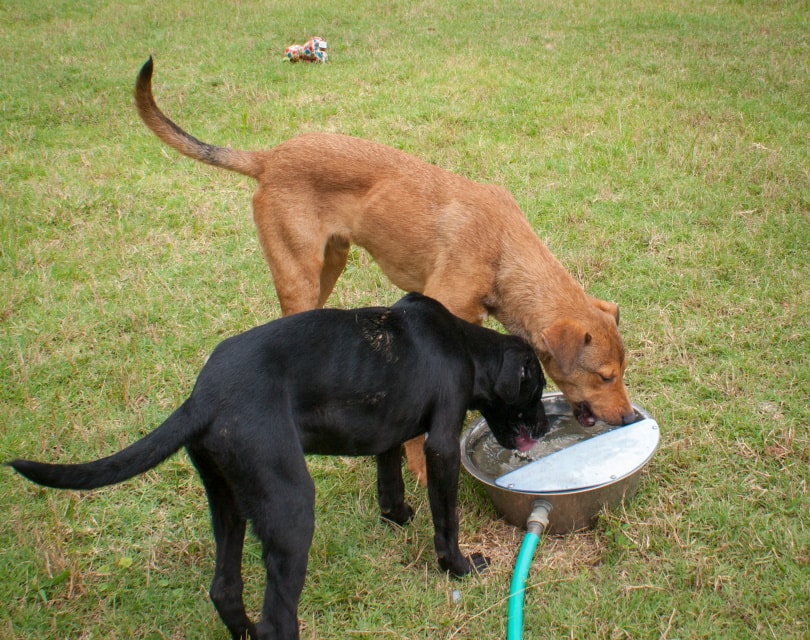There are few sounds that can make a dog owner’s blood run cold like the sound of a retching, vomiting dog. We’ll drop everything and come running the moment our beloved dog starts heaving only to find a small puddle of water on the floor. We’re often left scratching our heads while trying to determine what caused our pet to throw up and whether we should contact the vet about the issue.
Here are five reasons your pet may be vomiting water and some tips for preventing water-related illnesses.

The 5 Causes for Dogs Vomiting After Drinking Water
1. Drinking Water Too Quickly
One of the most common reasons your dog may throw up after drinking water is because it drank too quickly. Dog owners everywhere are familiar with the rapid lapping their pets do at the water bowl after a period of high activity, such as playing fetch or running. Your pet may be experiencing acute (one-time) regurgitation if it brings up water right after it finishes drinking.
If your dog throws up a clear, liquid vomit, the bout of vomiting is likely triggered by stomach secretions or water settling in the stomach. These two issues often occur when your dog drinks water when it’s feeling nauseous and the stomach is too unsettled to keep anything down. If your dog can’t keep anything down, contact your vet immediately so they can examine your pet.
2. Drinking Contaminated Fresh Water
Most of the time your pet won’t experience any harm from giving in to its instincts and lapping some water up from a fresh source, but several types of water can make your dog ill. Puddles, either at home or at the park, are often stagnant and can contain bacteria, viruses, or chemical runoff that can make your pet vomit or worse. Motionless lakes and ponds are often a haven for viruses, bacteria, algae, parasites, and fungi that can also make your dog ill.
If you’re going to be playing outside with your dog away from home, it’s a good idea to get a travel bowl to bring on outings with you. Pull out the bowl, fill it up with fresh water brought from home, and redirect your dog to the bowl to prevent illness from outdoor water sources.

3. Drinking Contaminated Water at Home
Nature isn’t the only source of contaminated water your pet may run across in their travels, as the home can also be a source of tainted water. Toilet water can make your dog vomit because they are treated with chemicals, such as cleaners, toilet bowl (or tank) disks, and bleach cleaners. The water becomes full of chemicals that can make your dog sick to its stomach and cause vomiting, so keep your toilet seats down if your dog loves the Porcelain God.
It’s important to always make sure your dog’s home water bowl is full of fresh, clear water. Fill up the water bowl a couple of times each day and make sure to clean the bowl often with soap and water to prevent bacteria buildup, which can make your dog ill.
4. Bloat
Bloat is a potentially life-threatening condition that needs to be evaluated by a vet as soon as symptoms become present. The dog experiences severe abdominal pain caused by the stretching of the stomach due to food, water, or gas, which can cause vomiting. In some cases, the bloat is so severe that it can cut off blood flow to the stomach and abdomen, as well as cause breathing problems by putting strain on the diaphragm.
Symptoms of bloat include drooling, panting, dry-heaving, abdominal distention, retching, pale gums, rapid heartbeat, anxiety, unable to get comfortable, collapse, and standing with their front paws on the ground while standing on their hind legs (downward-facing dog position).
If your dog vomits and you notice any of the previous symptoms, contact your vet immediately because bloat may be curable if caught early.

5. Megaesophagus
The esophagus is the tube that connects the throat to the stomach in many animals. Megaesophagus is a condition in which the esophagus is enlarged and causes decreased motility in this muscular tube. When esophageal motility is absent, food and liquid don’t move down to the stomach, and your dog may vomit.
Your pet could have been born with this condition, and it’s more often found in the following breeds:
- German Shepherds
- Miniature Schnauzers
- Irish Setters
- Pugs
- Shar-Pei
- Great Danes
- Wire-haired Fox Terriers
- Labradors
If your pet is experiencing vomiting, nasal discharge, excessive drooling, or coughing, it’s best to contact a vet to get it checked out.
 Regurgitation Versus Vomiting: An Important Difference
Regurgitation Versus Vomiting: An Important Difference
The process of regurgitation occurs when food or water moves back up the esophagus of your dog into its mouth before it ever reaches the stomach. In some instances, this happens because the dog ate or drank too quickly, but it can also be a symptom of a larger problem, such as cancer, an enlarged or narrow esophagus, or tumors.
Vomiting is the expulsion of the stomach contents accompanied by retching, abdominal heaving, and the reappearance of partially digested food and yellow bile. Vomiting can indicate a variety of health issues, including Addison’s disease, liver or kidney failure, ulcers, and more.
Whether your pet is regurgitating or vomiting water will be a vital clue for your vet to help determine what is making your dog ill. Make a note of your pet’s symptoms and be prepared to provide your vet with as much information as possible.
Our Favorite Products Incorporating Hepper's Advanced Bio-Enzyme Pet Stain & Odor Eliminator Spray and Wash Wipes makes for an excellent grooming and cleaning duo when you need it most. First, by keeping your pet fresh and clean on-the-go, and second, by removing smells and stains on various surfaces to leave your home fresher than ever.
At Dogster, we’ve admired Hepper for many years, and decided to take a controlling ownership interest so that we could benefit from the outstanding products of this cool pet company!
Conclusion
There is nothing like a retching, vomiting dog throwing up fluid to keep a dog owner on their toes. Throwing up water can be caused by overactivity, drinking contaminated water, disease, or internal physical deformities.
In many cases, an acute instance of your pet vomiting is not a concern, but if your pet is experiencing chronic vomiting or seems to be exercising severe abdominal discomfort, you should contact your vet immediately.
Related Read:
- Is Dog Vomiting Blood an Emergency? Vet-Approved Reasons & FAQ
- How to Get a Sick Dog to Drink Water: 12 Vet-Reviewed Steps to Follow
Featured Image Credit: Alexander Hagseth, Shutterstock



 Regurgitation Versus Vomiting: An Important Difference
Regurgitation Versus Vomiting: An Important Difference








